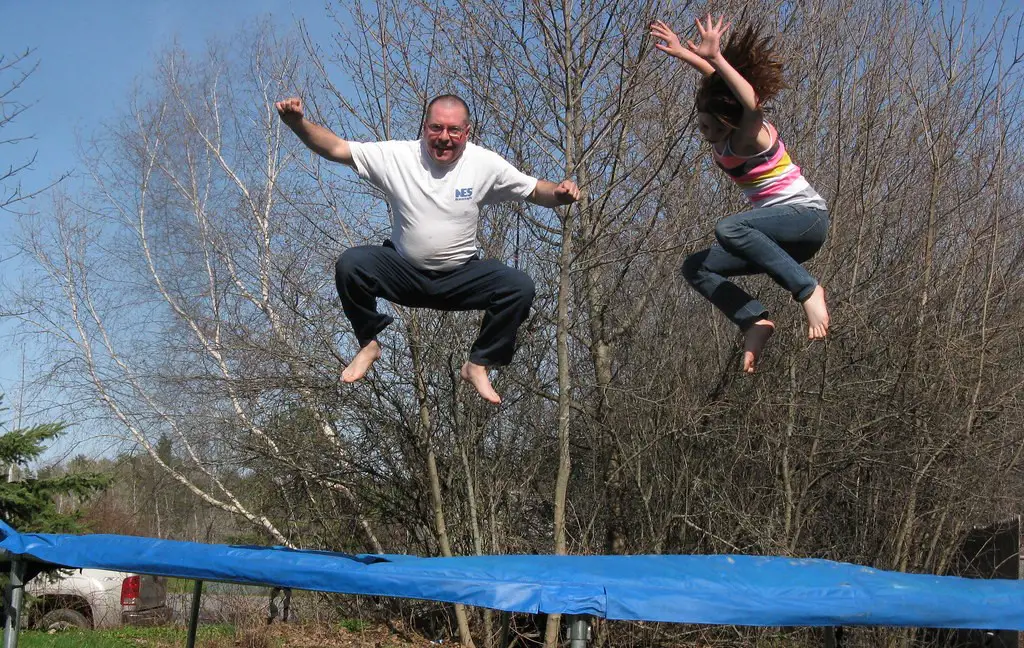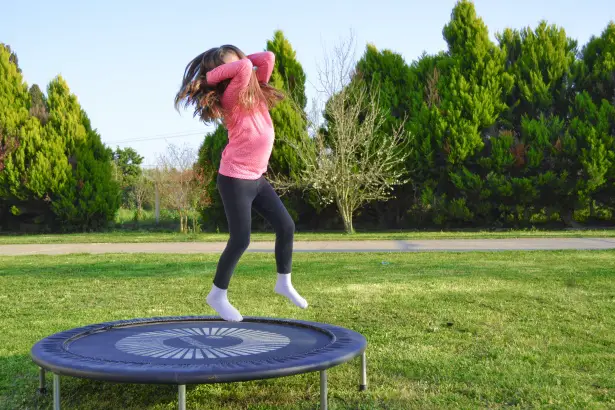It’s natural to wonder about the potential impact on my knees. Are trampolines bad for your knees? While it’s true that there are rare situations where trampolines can pose risks to the knees, such as inadequate safety equipment or improper landings, I believe that with proper care, many of these concerns can be avoided.
Trampolines offer a fantastic way to have fun, bond with family and friends, and stay active. However, it’s important to be mindful of safety precautions to ensure a positive and injury-free experience.
By understanding how trampolines can potentially harm our knees and implementing preventive measures, we can continue enjoying this activity while safeguarding our knee health.
Are Trampolines Bad for Your Knees: Trampolines can harm your knees if safety measures are neglected. Discover how to protect your knee health while still enjoying the fun of trampolining.
In what ways can jumping on a trampoline lead to knee damage?

One of the main reasons why trampolines can harm your knees is that many jumpers don’t take the potential damage seriously.
We often assume that jumping on a bouncy surface is completely safe for our knees without considering the risks involved. However, activities like flipping and jumping on a trampoline can lead to knee injuries.
Here are a few ways that jumping on a trampoline can negatively affect your knees:
Engaging in Stunt Activities on Trampolines:
Performing stunts on a trampoline without proper protection and guidance can lead to hyperextending your knees. This means your knees bend too far backward, causing excessive pain in the knee area.
In more serious cases, hyperextension can damage the soft ligaments inside your knee. This can result in reduced knee function and make it difficult for you to move around comfortably.
It’s important to be cautious when attempting stunts on a trampoline and ensure you have the necessary support and guidance to avoid these potential knee injuries.
Experiencing Unnecessary Impact on Your Knees:
Jumping directly from the trampoline to the ground can lead to a potentially severe injury, such as a broken knee joint. Our bodies get accustomed to the bouncing motion while jumping on a trampoline, but the ground doesn’t provide the same level of flexibility as the trampoline.
When we land on the ground after jumping, the knee joint is unprepared for the impact. This lack of flexibility can cause the knee cap to dislocate, resulting in immediate pain and discomfort.
To avoid this type of injury, it’s important to be cautious and avoid jumping directly from the trampoline to the ground. Instead, use a ladder or step off the trampoline safely to minimize the impact on your knees and reduce the risk of dislocating your kneecap.
Debunking the Trampoline Absorption Myth:
A widespread misconception about trampolines is that the bouncy surface and springs absorb all the shock from jumping, resulting in no pressure on your knees.
However, the reality is that while trampoline surfaces do absorb some of the shocks, a significant portion still impacts your knees. This can lead to unnecessary damage over time.
The excessive shock on your knees can potentially cause your kneecap to dislocate or contribute to wear and tear on the knee joint, leading to long-term issues.
It’s important to be aware of this fact and take precautions to protect your knees while using a trampoline.
Avoiding excessive or forceful jumps, maintaining proper landing techniques, and considering the use of knee supports can help minimize the impact on your knees and reduce the risk of injury.
Considering Pre-existing Knee Conditions:
Individuals with existing knee issues may inadvertently worsen their condition by jumping on a trampoline.
The repetitive jumping motion places continuous pressure on the knee joint, which can increase knee damage over time.
If you already have subtle knee problems, such as weak ligaments or cartilage issues, the strain from trampoline jumping can exacerbate those issues and cause further discomfort or injury.
It’s essential to be mindful of your knee health and consider the potential risks before engaging in trampolining activities.
Consulting with a healthcare professional or physiotherapist can guide whether trampolining suits your specific knee condition and offer recommendations for exercises or precautions to minimize the risk of aggravating your knee damage.
Addressing the Risks of Trampoline Collisions:
The risk of colliding with another person or object while using a trampoline can have serious consequences for your knees.
When jumping too high and at high speeds, collisions can significantly damage the knee joint, potentially requiring surgery to regain normal mobility.
Repetitive stress injuries are also common among frequent trampoline jumpers. While occasional jumping may not pose a significant problem, regularly performing trampoline stunts can be dangerous.
Landing in an awkward position during a stunt can lead to injuries requiring extended bed rest before being able to walk without difficulty.
One prevalent injury associated with trampoline jumping is known as Jumper’s knee. It is one of the most common tendinopathies in the United States, affecting up to 20 percent of regular trampoline jumpers.
Both male and female jumpers are equally susceptible to bilateral tendinopathy, while unilateral tendinopathy affects more male jumpers. This condition is a result of repetitive strain injuries and can also occur in children who frequently engage in trampoline jumping.
Can Trampoline Jumping Cause Knee Harm?

One of the main reasons trampolines can harm our knees is that many jumpers don’t take the potential risks seriously.
Often, we assume that jumping on a bouncy surface is completely safe for our knees since there are no apparent dangers.
However, performing flips and high jumps on a trampoline can lead to knee injuries.
It’s important to be aware of the risks and take necessary precautions to protect our knees while using a trampoline. Understanding the potential harm and being cautious in our actions can minimize the chances of knee injuries and enjoy trampolining safely.
What are the causes of Knee Pain experienced after trampling?
Excessive use of your knee joint, such as frequent jumping on hard surfaces, can lead to a condition known as jumper’s knee. This is a common injury often seen in sports activities where the leg muscles contract and impact the ground.
The strain on your tendon causes it to become inflamed due to repetitive stress and tension.
Are Trampolines Bad for Your Knees?
When you jump, the force exerted on your knees can be two to three times your body weight, putting them at a higher risk of injury. Individuals with knee problems need to avoid jumps that require a deep knee bend or involve knee twisting upon landing.
These types of jumps can further strain the knees and increase the likelihood of injury. Be mindful of these risks and choose jumping techniques that minimize knee stress to maintain their health and prevent potential damage.
Is Jumping on a Trampoline Detrimental to Your Health?
Jumping on a trampoline can be an enjoyable way to enhance your physical fitness and add variety to your exercise routine. It offers a low-impact workout that can help you build strength, improve heart health, and enhance your balance.
It’s a great way to stay active and reap the benefits of exercise while having fun at the same time.
Does Rebounding Provide Benefits for Arthritis?
Arthritis is a condition that causes severe pain and can limit mobility. However, patients who have tried rebounding on a mini-trampoline have reported significant improvements in their symptoms.
Jumping and bouncing slowly on a small trampoline is better than engaging in intense running or walking. Rebounding reduces about 80 percent of the strain on the knee joint, allowing you to gradually strengthen your knees without subjecting them to harsh impacts on hard surfaces.
If you’re uncertain about rebound exercise, try it on a mini-trampoline. It may be challenging at first, and you can only stay on the trampoline for a short time. However, don’t give up. With regular practice, you can increase your time on the trampoline and gradually build endurance.
After a few weeks, you’ll start to feel great, and your discomfort will decrease. Rebounding on a mini-trampoline can benefit individuals with arthritis, providing relief and improving overall well-being.
Is it Safe to use a Rebounder if you have a Bad Knee?
Whether or not it is safe to use a rebounder with a bad knee depends on your comfort level. It’s important to understand that injuring your knee through impact or twisting differs from having a chronic condition like arthritis.
If you have recently injured your knee, it’s not advisable to immediately start jumping on the rebounder. Give yourself at least a week or two to allow the soreness to subside.
During this recovery period, avoiding intense exercises such as push-ups, squats, brisk walking, or running is best. Once you start feeling a bit better, you can gradually reintroduce rebounding on the trampoline. Compared to other high-impact sports, rebounding has a lower impact on the knees.
However, it’s important to start slowly and gently, even though rebounding is considered gentler on the knees. Avoid putting too much pressure on your knees on the first day back. Take your time to build up your strength and gradually increase your intensity as your knee allows.
Do Trampolines Offer Benefits for Individuals with Arthritis?
Trampolines can be beneficial for individuals with arthritis due to their anti-inflammatory properties. Rebounding on a trampoline promotes and supports lymphatic drainage, which helps reduce inflammation in the body.
Additionally, this activity helps lubricate the joints and relieves the pain and stiffness associated with arthritis. It can be a helpful form of exercise for managing arthritis symptoms.
Exercises on a Mini-Trampoline

On a small trampoline, you can perform various calisthenic-style exercises. Two popular exercises are walking and jogging in place. Simply walk or jog on the rebounding surface of the mini-trampoline.
When walking in place, lift your knees so that your thighs are nearly parallel to the ground. Swing your arms smoothly up and down as you walk.
Another set of exercises on the trampoline is jumping jacks and twists.
For jumping jacks, jump softly while bringing your right knee and left elbow close together, and then switch to continuously bringing your left knee and right elbow close together.
These exercises help you stay active and work for different muscle groups while enjoying the benefits of bouncing on a mini-trampoline.
Benefits of Mini Trampoline Exercises
Exercising on a mini trampoline offers several benefits. Unlike a regular trampoline, the smaller size of a mini trampoline reduces the gravitational pull on your body as you bounce, which helps alleviate strain on your knees.
The rebounding surface of a mini trampoline is typically around 3 feet in diameter, which limits how high you can jump compared to larger trampolines. This feature, along with the elasticity of the surface, makes mini trampoline exercises relatively safe for individuals with knee issues.
It provides a low-impact form of exercise that can benefit those looking to protect their knees while staying active.
Choosing the Right Trampoline for Knee Health
When you have knee problems, selecting the right rebounder is crucial. Look for a trampoline that doesn’t have springs when you go shopping.
Springless trampolines are designed to absorb the impact of your bounce, which benefits your knees. On the other hand, trampolines with springs may not provide the same level of impact absorption.
Engaging in low-impact workouts that won’t strain your knees is important for individuals with bad knees. Opting for a springless trampoline will make bouncing easier and more flexible, ultimately benefiting your knees in the long term.
A mini trampoline with a diameter of around 3 feet is highly recommended. It offers controlled and gentle jumps and rebounds, minimizing knee stress.
When dealing with a chronic knee condition, it’s essential not to overexert yourself. Being overly active can lead to inflammation in your tendons and ligaments.
To ensure comfortable rebounding, wear athletic shoes. They provide thick cushioning that helps reduce the impact on any hard surface, providing additional support for your knees.
Trampoline Knee Injury Adults
Knee injuries can occur in adults while using a trampoline, and it’s important to be aware of the potential risks. Some common knee injuries that adults may experience on a trampoline include:
- Sprains and Strains: Awkward landings or sudden jumping movements can strain or sprain the ligaments and muscles surrounding the knee joint.
- Torn Meniscus: A sudden twist or direct impact can cause a tear in the meniscus, which is the cartilage that cushions the knee joint.
- Patellar Tendonitis: Overuse of the knee joint during repetitive jumping can lead to inflammation and pain in the patellar tendon, which connects the kneecap to the shinbone.
- Dislocated Kneecap: Landing in an awkward position or colliding with another person or object on the trampoline can result in the kneecap being forced out of its normal position.
To reduce the risk of knee injuries while using a trampoline, it’s important for adults to:
- Use proper technique: Maintain good body control, land with knees slightly bent, and avoid excessive twisting or overexertion.
- Warm up and stretch: Prepare your muscles and joints for activity by warming up and stretching before using the trampoline.
- Supervise and follow safety guidelines: Always use the trampoline in a supervised environment and follow the manufacturer’s safety guidelines, including weight restrictions and the number of jumpers allowed.
- Wear appropriate footwear: Consider wearing supportive athletic shoes with good cushioning to help absorb impact and stabilize the knees.
If you experience persistent pain, swelling, or difficulty moving your knee after a trampoline injury, seeking medical attention is important. A healthcare professional can properly evaluate your condition and provide appropriate treatment recommendations.
Trampoline Knee Injury Child
Trampoline knee injuries can occur in children, posing potential risks to their knee health. Common injuries include sprains and strains from landing awkwardly or twisting the knee, fractures due to forceful landings or collisions, dislocated kneecaps from landing in an unusual position, and patellar tendonitis caused by overuse.
It’s important to prioritize safety measures and supervise children closely to minimize the risk of knee injuries while using a trampoline.
Is Walking on Concrete Bad for Your Knees?

Walking on concrete surfaces for extended periods can potentially be hard on your knees. Concrete is a rigid and unforgiving surface that doesn’t provide much cushioning or shock absorption.
This can increase impact and stress on the joints, including the knees. Over time, repetitive walking on concrete without proper footwear or breaks can contribute to knee discomfort, pain, and even the development of conditions like osteoarthritis.
It is advisable to wear supportive shoes with cushioning and consider taking breaks or alternating walking surfaces to reduce the strain on your knees.
Are Mini Trampolines Good for Bad Knees?
Mini trampolines can be beneficial for individuals with bad knees. The smaller size of mini trampolines and their rebounding surface provide a controlled and gentle bouncing experience.
Compared to larger trampolines, mini trampolines exert less gravitational pull on the body, reducing knee strain. Additionally, the elasticity of the rebounding surface helps absorb impact, further minimizing stress on the knee joints.
However, it’s important to exercise caution, start slowly, and listen to your body’s limits. If you have severe knee issues, it is always advisable to consult with a healthcare professional before engaging in any new exercise routine.
Is Walking Too Much Bad for Your Knees?
Walking is generally a low-impact activity that benefits overall health, including joint health. However, excessive or repetitive walking without proper rest and recovery can potentially be hard on your knees.
Factors such as walking on hard surfaces, wearing improper footwear, or having pre-existing knee conditions may increase the risk of knee discomfort or injury.
It’s important to maintain a balanced approach to walking, incorporating rest days, wearing supportive shoes, and listening to your body’s signals.
If you experience persistent or severe knee pain while walking, it’s advisable to consult with a healthcare professional for an evaluation and appropriate guidance.
Mechanics of Trampolines
Trampolines work on the principle of elasticity and provide a spring-like surface for jumping and bouncing. They consist of a sturdy frame made of metal or plastic and a flexible jumping mat or surface that is connected to the frame using springs or elastic bands.
When a person jumps on a trampoline, the mat or surface stretches downward, storing potential energy. As the person pushes off the mat, the stored energy is released, propelling them into the air. This upward force generates a feeling of weightlessness and allows for various movements and tricks.
The springs or elastic bands connecting the mat to the frame play a crucial role in the mechanics of trampolines. They absorb and distribute the energy of the jump, allowing for a controlled and responsive bouncing experience.
The tension in the springs or elastic bands provides resistance and determines the bounce level.
Trampolines are designed to provide a safe and enjoyable jumping experience. However, it is important to follow safety guidelines, such as using protective padding, maintaining proper supervision, and avoiding risky maneuvers, to prevent accidents and injuries while using trampolines.
Precautions and Safety Measures
Trampoline Setup and Maintenance:
- Proper Installation: Follow the manufacturer’s instructions for assembling and setting up the trampoline to ensure its stability and safety.
- Regular Inspections: Inspect the trampoline for any damage, loose parts, or wear and tear. Replace or repair any worn-out or damaged components promptly.
- Secure Surrounding Area: Clear the surrounding area of any sharp objects, obstacles, or hazards that may pose a risk of injury while using the trampoline.
Safety Guidelines for Users:
- Supervision: Ensure that trampoline use is supervised, especially for children, to prevent risky behavior or accidents.
- One User at a Time: Allow only one person to use the trampoline at a time to minimize the risk of collisions or falls.
- Age and Weight Restrictions: Follow the manufacturer’s recommended age and weight limits to ensure safe usage.
- Proper Attire: Wear appropriate clothing, including athletic shoes, to provide traction and reduce the risk of slipping or tripping.
- Warm-up and Stretching: Perform warm-up exercises and stretching before using the trampoline to prepare the body for physical activity.
Safe Jumping Techniques:

- Controlled Movements: Encourage users to perform controlled jumps and movements, avoiding excessive or erratic bouncing.
- Landings: Teach proper landing techniques, such as bending the knees and absorbing impact with the legs to minimize strain on the joints.
- Avoid Flips and Tricks: Discourage flips, somersaults, or complex acrobatic maneuvers that can increase the risk of injury.
- Exit Safely: Teach users to exit the trampoline safely by walking or stepping off rather than jumping or diving off.
Additional Safety Measures:
- Safety Enclosure: Consider using a safety enclosure or netting around the trampoline to prevent accidental falls off the jumping surface.
- Protective Padding: Install adequate padding on the frame, springs, and surrounding areas to cushion impact and reduce the risk of injury.
- Regular Maintenance: Maintain the trampoline by inspecting and tightening the springs, replacing worn-out padding, and ensuring the safety features are intact.
It is important to note that these precautions and safety measures cannot guarantee complete injury prevention. However, when followed diligently, they can significantly reduce the risks associated with trampoline usage. Always prioritize safety and exercise caution while using a trampoline.
Alternatives to Traditional Trampolines
Here are some alternatives to traditional trampolines:
Rebounders or Mini Trampolines:
These smaller trampolines offer a similar bouncing experience but with a reduced impact on the joints. They are compact and can be used indoors, making them suitable for individuals with limited space or those seeking a low-impact workout.
Bounce Houses:
Bounce houses, also known as inflatable trampolines, provide children a fun and safe jumping experience. They are made of inflatable materials and often come with safety nets and padded surfaces to minimize the risk of injuries.
Jumping Mats or Jumping Balls:
Jumping mats or balls are flat platforms or balls specifically designed for jumping exercises. They provide a stable surface and can be used for various low-impact workouts, such as aerobic exercises or balance training.
Trampoline Parks:

Trampoline parks are indoor facilities equipped with various trampolines and jumping areas.
They offer a controlled environment for safe and supervised trampoline activities, including foam pits, dodgeball courts, and obstacle courses.
Low-Impact Exercises:
If bouncing on a trampoline is not suitable for you, plenty of low-impact exercises provide similar benefits without putting excessive stress on the joints. Examples include walking, swimming, cycling, elliptical training, or using a stair climber.
When considering any alternative to traditional trampolines, it is important to prioritize safety, follow proper instructions and guidelines, and consider your fitness level and any existing health conditions.
Consulting with a healthcare professional or fitness instructor can help you choose the most suitable alternative for your needs.
Mitigating Knee Risks on Trampolines
Proper Warm-Up: Before jumping on a trampoline, it is essential to warm up your muscles and joints. Perform some light stretching exercises and movements to prepare your body for the activity.
Adequate Trampoline Padding: Ensure your trampoline has sufficient padding, especially around the frame and springs. This helps absorb impact and reduces the risk of knee injuries.
Use Safety Enclosures: Trampolines equipped with safety enclosures or nets provide an added layer of protection. They prevent jumpers from falling off the trampoline and potentially injuring their knees.
Controlled Jumping Techniques: Practice controlled jumping techniques, such as landing with slightly bent knees and keeping your feet aligned with your knees during jumps. Avoid excessive twisting or landing in awkward positions that may strain your knees.
Avoid Overexertion: Do not overexert yourself or attempt advanced stunts without proper training and supervision. Gradually increase the intensity and difficulty of your trampoline activities to avoid placing excessive strain on your knees.
Listen to Your Body: Pay attention to any discomfort or pain in your knees while jumping. If you experience persistent pain or discomfort, take a break and consult with a healthcare professional.
Supervision and Safety Guidelines: Ensure that trampoline use is supervised, especially for children. Follow all safety guidelines and rules to minimize the risk of knee injuries and other accidents.
Remember, while these measures can help mitigate knee risks on trampolines, it is important to consider individual factors such as existing knee conditions or injuries. If you have any concerns or pre-existing knee issues, consult a healthcare professional before trampoline activities.
FAQs:
Q:1 Is trampoline good exercise?
Yes, trampolining can be a good exercise. It provides a low-impact cardiovascular workout, improves balance and coordination, strengthens muscles, and can be enjoyable for people of various ages and fitness levels.
Q:2 Is trampoline good for weight loss?
Trampolining can be a beneficial component of a weight loss regimen. It helps burn calories, increases metabolism, and engages multiple muscle groups, making it a fun and effective exercise for weight management.
Q:3 Are trampolines bad for your knees?
Trampolines can be potentially harmful to your knees if proper precautions are not taken. Jumping with improper technique or landing incorrectly can lead to knee injuries.
Q:4 Can a trampoline cause knee pain?
Yes, trampolining can cause knee pain if the knees are subjected to excessive impact or stress. It is important to practice proper jumping techniques and avoid overexertion to minimize the risk of knee pain.
Q:5 How can I protect my knees while using a trampoline?
To protect your knees while using a trampoline, make sure to warm up before jumping, use proper landing techniques, avoid jumping too high, and wear supportive footwear. Additionally, using safety pads and a net enclosure can reduce the risk of accidental falls.
Q:6 Can trampolines worsen pre-existing knee conditions?
Trampolining may aggravate pre-existing knee conditions. Individuals with knee problems should consult their healthcare provider before using a trampoline and follow any recommended guidelines or restrictions.
Q:7 Are there any exercises on a trampoline that are knee-friendly?
Yes, there are exercises on a trampoline that are knee-friendly. Low-impact movements such as gentle bouncing, walking in place, and light aerobic exercises can provide a workout without putting excessive strain on the knees. It is important to listen to your body and modify the intensity as needed.
Conclusion:
In conclusion, the question of whether trampolines are bad for your knees is not a straightforward one. While there is a potential for knee injuries and damage when using trampolines, it largely depends on various factors such as proper technique, safety measures, and individual circumstances.
Trampoline-related knee injuries can occur due to improper landing, performing high-impact stunts, colliding with other objects or people, or having pre-existing knee conditions.
However, with proper care, precautions, and responsible use, trampolines can still be enjoyed without significant harm to your knees. It is crucial to follow safety guidelines, use safety equipment like padding and enclosures, and avoid pushing beyond your limits.
Learning and practicing correct jumping techniques, such as landing with bent knees and evenly distributing the impact, can also help reduce the strain on your knees.
It’s important to listen to your body and be aware of any discomfort or pain. If you have pre-existing knee issues or concerns, it is advisable to consult with a healthcare professional before engaging in trampolining or any high-impact activities.
Ultimately, trampolines can offer a fun and effective way to engage in physical activity, improve cardiovascular health, and strengthen muscles.
By being mindful of safety and taking necessary precautions, you can minimize the risks and enjoy the benefits of trampolining while keeping your knees as safe as possible.
We hope you will be well aware that are trampolines bad for your knees, after reading this comprehensive article. If you have any questions, feel free to comment below!

